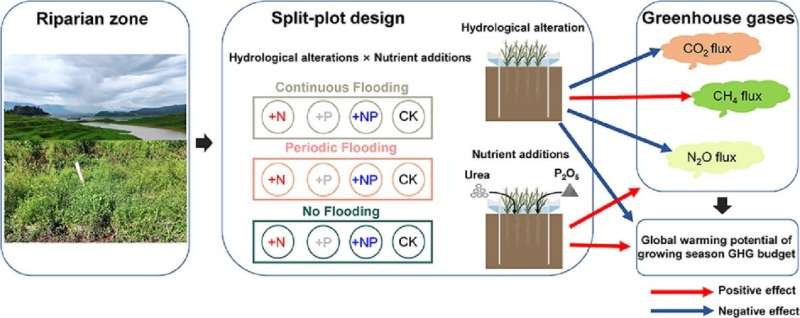Hydrological alteration and nutrient input greatly affect greenhouse gas emission

Changes in global rainfall patterns and the construction of artificial dams have led to widespread alteration of hydrological processes in riparian ecosystems. Meanwhile, intensified agricultural activities have resulted in enhanced inputs of nitrogen (N) and phosphorus (P) into the riparian ecosystems associated with the Yangtze River. However, it remains unclear how the greenhouse gases (CO2, CH4, and N2O) respond to both the hydrological alterations and nutrient input in the riparian zone.
To investigate the effects of hydrological changes and nutrients input on the greenhouse gases in riparian zone, Ph.D. student Shi Wenjun, supervised by Prof. Zhang Quanfa and Ye Chen of the Wuhan Botanical Garden of the Chinese Academy of Sciences, conducted an in situ experiment in the water level fluctuation zone of the Three Gorges Reservoir.
This experiment was carried out at Zhongxian Revegetation Station of Chongqing, China. The prescribed hydrological alterations (i.e., continuous flooding, periodic flooding, no flooding) and nutrients addition experiments (N addition, P addition, N + P addition, and control plots) were established at nine 15×3 m blocks along the elevation gradient.
Results revealed that hydrological alterations significantly affected the emissions of three greenhouse gases. Continuous flooding significantly reduced CO2 and N2O emissions across all the nutrient addition treatments, but greatly increased CH4 emissions.
The simultaneous addition of nitrogen and phosphorus promoted the emission of greenhouse gases, while phosphorus addition alone significantly reduced the N2O fluxes.
The quantitative PCR approach (qPCR) analysis revealed that continuous flooding significantly reduced the abundances of functional genes associated with CH4 oxidation, nitrification, and denitrification process, while N+P addition increased the abundances of functional genes.
Therefore, hydrological alterations and nutrients input mainly affect greenhouse gases emissions by changing soil environmental factors (soil redox conditions, moisture content, soil organic carbon) and the abundance of related functional genes.
Using the widely used global warming potential (GWP, on a 100-year time horizon), this study estimates that the water level fluctuation zone of the Three Gorges Reservoir has a positive net GWP. Continuous flooding treatment could reduce GWP, while N+P will increase GWP.
This research is of great significance for clarifying the mechanism of greenhouse gases emissions of the riparian ecosystems and calculating the carbon budget of the water level fluctuation zone of the Three Gorges Reservoir.
The research was funded by the National Natural Science Foundation of China, and the Youth Innovation Promotion Association of CAS.
Results were published online in Water Research, titled "Divergent effects of hydrological alteration and nutrient addition on greenhouse gas emissions in the water level fluctuation zone of the Three Gorges Reservoir, China."
More information: Wenjun Shi et al, Divergent effects of hydrological alteration and nutrient addition on greenhouse gas emissions in the water level fluctuation zone of the Three Gorges Reservoir, China, Water Research (2021). DOI: 10.1016/j.watres.2021.117308
Provided by Chinese Academy of Sciences



















